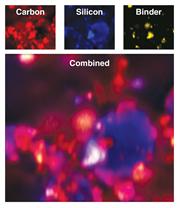Greener transport
Renishaw's StreamLine™ imaging technique is the ideal tool to help in the research for higher-performing battery components for the motor manufacturing industry made from chemically and structurally robust materials
29 March 2011

Motor manufacturers regularly announce the release of novel battery powered electric vehicles. Compared to the lithium-ion batteries in cell phones or notebook PCs, the batteries used in cars require very high output power, short charging time, long life, excellent safety, light weight, and low production cost. This translates into a need for higher-performing battery components made from chemically and structurally robust materials.
Silicon is attracting much interest as an alternative anode material to the graphitic carbon used in conventional lithium-ion batteries, as it offers up to 10 times the charge and discharge efficiency. However, silicon anodes are not as durable as their carbon counterparts. Research suggests that durability can be improved if the silicon is coated with a thin layer of carbon, and, since both these elements yield characteristic Raman spectra, Renishaw's StreamLine imaging technique is the ideal tool to help in the research.
The Raman images provide valuable insights into the distribution, homogeneity, and structure of the Si-C composite anode particles, which, in turn, can be related to electrical performance. These images can be acquired in a matter of minutes, and without exposing the samples to air, making Raman a strong candidate for QC in situ testing when these new materials go into production.
For further information on Renishaw's StreamLine visit www.renishaw.com/streamline
(Image caption: inVia™ microscope StreamLine Raman images of carbon (red), silicon (blue) and binder (yellow) show the distribution of the individual components. Blue areas in the combined image show where silicon is predominant, indicating an absent or thinner carbon coating compared to other areas.)
Downloads
All images and text copyright Renishaw
News updates
Register for regular news updates from Renishaw
